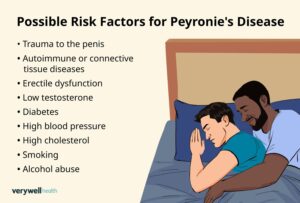How the Diagnosis of Peyronie’s Disease is made:
Health care professionals often can figure out if someone has Peyronie disease by doing a physical exam. They also might do tests to check for other conditions that can cause similar symptoms.
You might need the following tests:
- Physical exam. Your health care professional feels your penis when it’s not erect to figure out the location and amount of scar tissue. The length of your penis also might be measured. If the condition becomes worse, this measurement helps determine whether the penis has gotten shorter.Your health care professional also might ask you to bring in photos of your erect penis taken at home. This can help determine the degree of curving, the location of scar tissue or other details that might guide treatment.
- Other tests. Your health care professional might order an ultrasound or other tests to check your penis when it’s erect. Before testing, you’ll likely receive a shot directly into the penis that helps it become erect.Ultrasound is the most commonly used test for penis conditions. It uses sound waves to make images of soft tissues inside the body. These tests can show the presence of scar tissue, blood flow to the penis and any other irregular signs.
Treatment of Peyronie’s Disease:
Treatment options for Peyronie disease depend on how long it’s been since you began having symptoms.
- Acute phase. As scar tissue forms, changes in the curve or length of the penis become worse. You also may have pain during erections. The acute phase may last for 5 to 18 months.
- Chronic phase. The scar tissue in the penis stops growing, and your symptoms become stable. You also have no penile pain or changes in the curve, length or other aspects of the penis. The chronic phase happens later in Peyronie disease.
Acute phase Peyronie disease treatment
For the acute phase of the condition, treatments include:
- Traction therapy. When used early in the process, a device that holds the penis in a cradle and applies tension can be helpful. This is called penile traction therapy. It prevents length loss and limits curving.
- Medicines. Some medicines taken by mouth or given in shots are options in this phase. Some medicines that have been used in the past clearly do not work. Others may or may not help. Your health care professional will likely talk with you in more detail.
Surgery is not recommended in the acute phase of Peyronie disease. It isn’t a treatment option until the condition stops becoming worse and any pain goes away. This lowers the chances of needing a second surgery.
Chronic phase Peyronie disease treatment
For the chronic phase of the disease, treatment choices include:
- Watchful waiting, in which your health care team watches your condition closely and gives treatment if your symptoms become worse.
- Injections or shots into the scar tissue.
- Stretching devices, also called “traction” therapy.
- Surgery to straighten the penis.
These treatments may be done alone or combined with one another.
Oral medications taken by mouth aren’t recommended in the chronic phase. They haven’t been shown to be effective at this stage of the disease.

